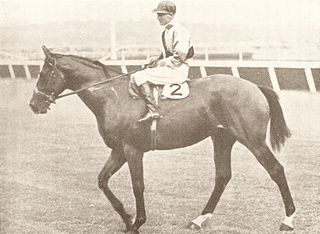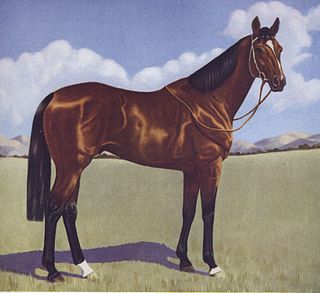Related Research Articles
Better Loosen Up was an Australian Thoroughbred racehorse that won the Japan Cup in 1990 and was named Australia's champion racehorse in 1991. He campaigned from two to seven years of age, and won 17 of his 45 starts, including eight Group One races. In 2004, he was inducted into the Australian Racing Hall of Fame.
Octagonal was a champion New Zealand-bred, Australian raced Thoroughbred racehorse, also known as 'The Big O' or 'Occy'. He was by the champion sire Zabeel, out of the champion broodmare Eight Carat, who also produced Group One winners Mouawad, Kaapstad, Diamond Lover and (Our) Marquise.

Vain (1966–1991) was a champion Thoroughbred racehorse that dominated Australian sprint racing in the period 1968–70, when he won 12 of the 14 races he contested and ran second in the other two. He went on to become a leading sire in Australia.
Sunline (1995–2009) was a New Zealand-bred Thoroughbred racehorse who was the world's highest earning racemare of her time, competing on 48 occasions for 32 wins, 9 seconds and 3 thirds to earn A$11,351,607. She won races in three different countries, Australia, New Zealand and Hong Kong. She won successive W.S. Cox Plates (2,040m), the richest Weight for Age (WFA) race in Australia. She also twice won the toughest mile race in Australia, the Doncaster Handicap, once as a three-year-old and then again as a six-year-old. She was named New Zealand Horse of the Year four times and is also the first of only 3 horses ever to win the Australian Horse of the Year championship three times, the others being Black Caviar and Winx. The only horse besides Sunline to win as many major races in both Australia and New Zealand was Gloaming, who raced around 1915.

High Caste was a Thoroughbred racehorse and stallion that was bred in New Zealand and was considered the best two-year-old in New Zealand after winning three of his four race starts. He was a good racehorse under handicap and weight for age conditions and combined this with wins in good races from 5 furlongs to 1 3⁄4 miles (2,800 m), carrying up to 10 stone 6 pounds.

Poseidon was an Australian Thoroughbred Hall of Fame racehorse. He won 19 races over distances ranging from five furlongs to three miles. Sixteen of these wins were "Principal Races", eight of them now of Group 1 (G1) status.

The Trump was an Australian-bred Thoroughbred racehorse who won the Caulfield-Melbourne Cup double as well as two other principal (G1) races in 1937. He showed his versatility by winning races over distances of six furlongs to two miles.

Nightmarch, foaled in 1925 was an outstanding New Zealand bred Thoroughbred racehorse known as The Kiwi. He won the New Zealand Derby and Dunedin Cup as a three-year-old before going to Australia where he became the first horse to win both the Melbourne Cup and Cox Plate in the same year, as well as other Principal races.

Super Impose was a New Zealand-bred Thoroughbred racehorse who was inducted into the Australian Racing Hall of Fame. In a career spanning 74 starts, he won eight Group One races and a then Australasian record $5.6 million in prize money. Trained throughout his career by Lee Freedman and ridden in his Group One wins by Bruce Compton (once), Darren Gauci (once), Darren Beadman, and Greg Hall (once), Super Impose won the AJC Epsom and Doncaster Handicaps two years in a row, in 1990 and 1991, and won the Cox Plate at his penultimate start as an eight-year-old in 1992.

Shannon (1941–1955), named Shannon II in America, was an outstanding Australian Thoroughbred racehorse who was inducted into the Hall of Fame. He created new racecourse records in Australia before he was sold to an American buyer who exported him to California in 1948. There Shannon equalled the world record of 1:473⁄5 for the nine furlongs in winning the Forty Niner Handicap Stakes, then one week later equalled the world record of 1:594⁄5 for a mile and a quarter. Shannon was named the 1948 American Champion Older Male Horse. At stud in America he proved to be a good sire.

Tulyar (1949–1972) was an Irish bred, British-trained Thoroughbred racehorse and sire. He won The Derby, the St. Leger Stakes, the King George VI and Queen Elizabeth Stakes, the Ormonde Stakes and the Eclipse Stakes setting a record for a single season's earnings in England. He stood at stud in Ireland and America, but failed to live up to expectations as a sire.
Weekend Hussler is a retired Australian Thoroughbred racehorse. He is a bay gelding by Hussonet out of Weekend Beauty. He was foaled in 2004. Hussonet had been a very successful sire in Chile for Haras de Pirque where he stood for the largest fee of any stallion in the history of Chilean Thoroughbred breeding.

Amounis was an Australian Thoroughbred Hall of Fame racehorse. He won 33 races over distances ranging from 6 to 12 furlongs. Of these wins, 27 were in "Principal Races", 16 of these races have since been promoted to Group One (G1) status. In winning the AJC Epsom Handicap he established a new Australasian record time.

Briseis foaled in 1873, was a brown Australian Thoroughbred filly that is regarded as one of the greatest mares ever foaled in Australia. As a two-year-old she won the AJC Doncaster Handicap and the weight for age (w.f.a.) AJC All Aged Stakes. Then as a three-year-old she won the VRC Victoria Derby, the Melbourne Cup and the VRC Oaks, all within six days.
Hareeba (1990–1997) was an Australian Thoroughbred racehorse who won six Black Type races including two Group One (G1) sprints in the 1990s.

Typhoon Tracy was an outstanding Australian Thoroughbred racemare who won six group one (G1) races and was crowned Australian Racehorse of the Year for 2009/10.

Tulloch (1954–1969) was a Thoroughbred racehorse, who is regarded as one of the finest racehorses in Australian racing history. He won at distances from 5 furlongs to 2 miles, established Australian records at 10 furlongs and 12 furlongs, and took 2 seconds off Phar Lap's 28-year-old record for the AJC Derby. As a three-year-old Tulloch won 14 of his 16 starts before he was struck down by a virus which kept him off the racing scene for almost two years. He returned to racing as an autumn five-year-old and won 15 of his last 24 races.

Wenona Girl was a leading Australian Thoroughbred horse racemare that had 27 wins over distances ranging from 4½ furlongs to 1½ miles. She won 22 principal races, 15 of which were later designated group one (G1) races. Wenona Girl’s principal wins included the VRC Sires Produce Stakes, AJC Sires Produce Stakes, George Adams Handicap, One Thousand Guineas, VATC Futurity Stakes, AJC George Main Stakes, AJC All Aged Stakes, AJC Adrian Knox Oaks Stakes, Rawson Stakes and Rosehill Guineas, all of which were later classified as G1 races. At the time of her retirement she was the highest stakes winning mare to have raced in Australia. At stud she was a good broodmare. Wenona Girl was later inducted into Australian Racing Hall of Fame.
Research was a champion Australian Thoroughbred racehorse who as a three-year-old carved out a unique place in Australian racing history by becoming the only filly to win the AJC Derby-AJC Oaks double.
Boldboy was an Irish-bred, British-trained Thoroughbred racehorse. He raced for eight seasons in the 1970s and was one of the most popular and successful racehorses of his era. As a two-year-old he showed ability, but his ungovernable temperament led to his being gelded. In the following year he won the Greenham Stakes, Prix de la Porte Maillot, Diadem Stakes and Challenge Stakes. In 1974 he won the Lockinge Stakes and recorded the first of his four wins in the Abernant Stakes. After failing to win in 1975 he returned to form in 1976 to win the Abernant Stakes and the Sanyo Stakes. He reached his peak in 1977, when he repeated his previous wins in the Abernant Stakes, Sanyo Stakes and Challenge Stakes as well as taking the Vernons Sprint Cup. He won a fourth Abernant Stakes in 1978 and was retired in the following year. Apart from his wins he was placed in many important races but, as a gelding, was unable to compete in European Group One events under the rules which prevailed at the time.